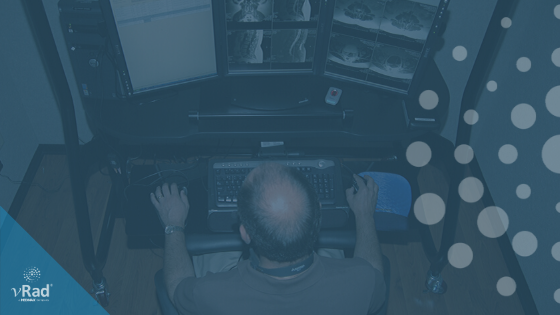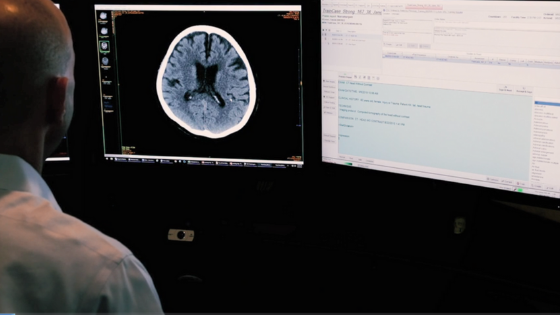What vRad’s Sale Will Mean for Radiologists and Clients
Our practice is for sale. And frankly, I’m pretty excited about it. Based on past experiences, the sale of vRad bodes well for the future of our...

Remote radiologist jobs with flexible schedules, equitable pay, and the most advanced reading platform. Discover teleradiology at vRad.

Radiologist well-being matters. Explore how vRad takes action to prevent burnout with expert-led, confidential support through our partnership with VITAL WorkLife. Helping radiologists thrive.

Visit the vRad Blog for radiologist experiences at vRad, career resources, and more.

vRad provides radiology residents and fellows free radiology education resources for ABR boards, noon lectures, and CME.

Teleradiology services leader since 2001. See how vRad AI is helping deliver faster, higher-quality care for 50,000+ critical patients each year.

Subspecialist care for the women in your community. 48-hour screenings. 1-hour diagnostics. Comprehensive compliance and inspection support.

vRad’s stroke protocol auto-assigns stroke cases to the top of all available radiologists’ worklists, with requirements to be read next.

vRad’s unique teleradiology workflow for trauma studies delivers consistently fast turnaround times—even during periods of high volume.

vRad’s Operations Center is the central hub that ensures imaging studies and communications are handled efficiently and swiftly.

vRad is delivering faster radiology turnaround times for 40,000+ critical patients annually, using four unique strategies, including AI.
.jpg?width=1024&height=576&name=vRad-High-Quality-Patient-Care-1024x576%20(1).jpg)
vRad is developing and using AI to improve radiology quality assurance and reduce medical malpractice risk.

Now you can power your practice with the same fully integrated technology and support ecosystem we use. The vRad Platform.

Since developing and launching our first model in 2015, vRad has been at the forefront of AI in radiology.

Since 2010, vRad Radiology Education has provided high-quality radiology CME. Open to all radiologists, these 15-minute online modules are a convenient way to stay up to date on practical radiology topics.

Join vRad’s annual spring CME conference featuring top speakers and practical radiology topics.

vRad provides radiology residents and fellows free radiology education resources for ABR boards, noon lectures, and CME.

Academically oriented radiologists love practicing at vRad too. Check out the research published by vRad radiologists and team members.

Learn how vRad revolutionized radiology and has been at the forefront of innovation since 2001.

%20(2).jpg?width=1008&height=755&name=Copy%20of%20Mega%20Nav%20Images%202025%20(1008%20x%20755%20px)%20(2).jpg)

Visit the vRad blog for radiologist experiences at vRad, career resources, and more.


Explore our practice’s reading platform, breast imaging program, AI, and more. Plus, hear from vRad radiologists about what it’s like to practice at vRad.

Ready to be part of something meaningful? Explore team member careers at vRad.

Ergonomics is the study of people’s interaction with their environment and provides principles and theories for proper design of the workplace. Ergonomics is a concept that has been around for quite some time, but it is often something that we don’t spend a lot of time thinking about as we go about our workday. If you find yourself sitting at a desk for long periods of time, you may experiences aches and pains that can be eliminated with a few adjustments to your work environment. Not only does ergonomics help you be more comfortable at work, but can reduce stress, prevent injuries and improve productivity.
Below is a quick assessment you can do for your individual workstations.
- Make sure the chair height is set properly so that your elbows are at desktop level.
- Your knees should be level with your hips.
- Your feet should comfortably reach the floor. If your feet don’t reach the floor consider using a foot rest. Get creative – a stack of sturdy books or a small stool can work if you don’t want to purchase a foot rest.
- Adjust your seat back so that you have good lumbar support. Use a cushion or pillow if needed.
- The computer monitor should be directly in front of you at about arm’s length away.
- The top of your monitor should be slightly below your eye level.
- Mouse should be alongside your keyboard and make sure to keep your wrist and elbow in a natural and comfortable position.
- Keyboard should be close to the edge of your desk.
- If you are on your phone a lot, consider using a headset rather than cradling the phone between your head and neck.
- Shoulders should be relaxed.
- Position your forearms parallel to the floor or slightly angled.
- Wrists should be in a neutral position and not resting on the sharp edge of your desk.
- Upper arms should be close to the side of your body.
What tips do you have for making your workplace more comfortable?
Back to Blog.png)
Our practice is for sale. And frankly, I’m pretty excited about it. Based on past experiences, the sale of vRad bodes well for the future of our...

The vRad Imaging Platform employs multiple AI models in processing over 20,000 radiology studies each day. Silently prioritizing critical cases is...
-1.png)
The pandemic made one thing very clear: Practices must become more agile to survive inevitable imaging volume fluctuations in the coming months and...
vRad (Virtual Radiologic) is a national radiology practice combining clinical excellence with cutting-edge technology development. Each year, we bring exceptional radiology care to millions of patients and empower healthcare providers with technology-driven solutions.
Non-Clinical Inquiries (Total Free):
800.737.0610
Outside U.S.:
011.1.952.595.1111
3600 Minnesota Drive, Suite 800
Edina, MN 55435